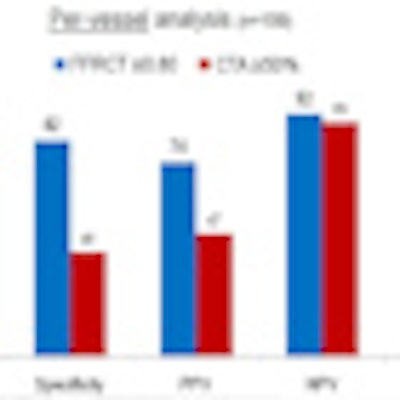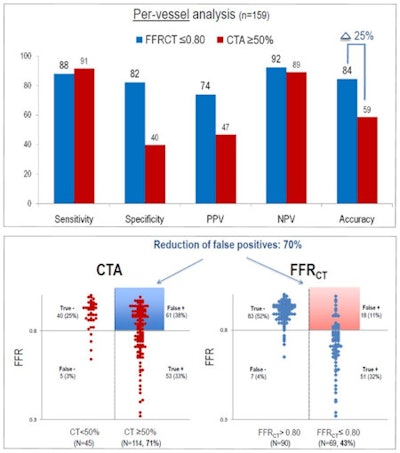
New evidence suggests the diagnostic accuracy of CT angiography (CTA) can be increased by 25% using a novel postprocessing technique, yielding clinically rich information revealing the extent of arterial stenoses for patients with coronary artery disease.
Compared with diagnoses using CTA alone, the computed analysis of data can result in a 70% reduction in false positives and a twofold increase in true negatives. More significant for cardiologists was the finding from the Diagnosis of Ischemia-Causing Stenoses Obtained Via Non-invasive Fractional Flow Reserve (DISCOVER-FLOW) clinical trial that the investigational software for CT postprocessing returned an excellent correlation with fractional flow reserve (FFR), presenting an alternative and noninvasive method for assessing coronary lesions that currently can only be determined using a catheter-based reading during percutaneous coronary intervention (PCI).
The results of this first-in-man application of virtual FFR using CTA data were presented at last week's Paris Course for Revascularization, or EuroPCR, Europe's largest congress for cardiac interventions. FFR was awarded a Class I recommendation with Level I evidence in the 2010 guidelines for myocardial revascularization published jointly by the European Society of Cardiology and the European Association for Cardio-Thoracic Surgery.
By pushing a pressure-sensitive wire through a coronary lesion during PCI, a cardiologist can measure the severity of blood flow blockages in a specific artery and decide whether a stent is required to repair the lesion. The concern, however, is for lesions with an intermediate stenosis in the range of 50% to 70% closure. Without a functional assessment using FFR, the accepted practice is to place a stent in all suspect lesions, resulting in overtreatment of patients.
The landmark Fractional Flow Reserve vs. Angiography in Multivessel Evaluation (FAME) study published in the 15 January 2009 issue of the New England Journal of Medicine demonstrated that treatment guided by FFR rather than by standard angiography alone reduced by 28% instances of major adverse cardiovascular events, including death, heart attack, and repeat revascularization (NEJM, 15 January 2009, Vol. 360:3, pp. 213-224). Follow-up analysis of the FAME study presented at EuroPCR 2011 demonstrated substantial cost savings for national healthcare systems when FFR is used during PCI.
The CT-based FFR (CT-FFR) technique may help further reduce unnecessary invasive coronary angiography and revascularization procedures, according to Dr. Bon-Kwon Koo, from Seoul National University Hospital in South Korea, who presented the findings from the multicenter DISCOVER-FLOW study. Developed at Stanford University, the CT-FFR analysis is run on a supercomputer using raw DICOM data from any existing CTA performed with a scanner of 64 detector rows or higher. After constructing a 3D map of the heart, a computational model of the hemodynamics of arteries provides readings for FFR at any point on the map, enabling a cardiologist to assess the severity of stenosis in each lesion.
"We can measure the velocity, pressure, and shear stress on plaque formations to determine the risk for a patient," Koo told AuntMinnieEurope.com. "Theoretically, we can see how a single red blood cell moves through the coronary arteries."
Preoperative assessment with CT-FFR is not meant to replace the intraoperative use of invasive FFR, he noted. Instead, its value is significantly enhancing the diagnostic quality of CTA, which he said has a very nice sensitivity and negative predictive value, but a low specificity and low positive predictive value.
Dr. William Wijns, past president of the European Association of Percutaneous Coronary Intervention, said CT-FFR is potentially disruptive for other widely used noninvasive assessments of ischemia, such as echo stress tests and nuclear medicine using radioisotopes. More than 24 million noninvasive tests are performed in the U.S. each year, and another 11 million take place in Europe.
A larger intent-to-diagnose study of CT-FFR at 20 centers worldwide, called the Determination of Fractional Flow Reserve by Anatomic Computed Tomographic Angiography (DeFACTO) study, is currently at the midpoint of a 250 patient enrollment. The CT-FFR capability will be offered as a Web-based service by Heartflow, a start-up formed by the developers of the software based in Redwood City, California. Currently the processing of an uploaded DICOM files requires five hours, though Heartflow CEO John Stevens said he expects a two-hour turnaround by early next year. He said the service will be available in 2012 outside the U.S., and he hopes to receive a premarket approval from the U.S. Food and Drug Administration in 2013.
Comparative diagnostic performance for fractional flow reserve
CTA versus computed blood flow modeling
 Source: Charts provided by Dr. Bon-Kwon Koo, Seoul National University Hospital, Seoul, South Korea, from his presentation of the DISCOVER-FLOW clinical trial at EuroPCR 2011.
Source: Charts provided by Dr. Bon-Kwon Koo, Seoul National University Hospital, Seoul, South Korea, from his presentation of the DISCOVER-FLOW clinical trial at EuroPCR 2011.


















